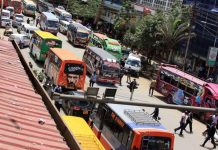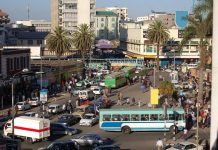The flip-flop experiment by the Nairobi county government to rid the city of traffic jams has come a cropper. The county transport department in conjunction with the mother ministry should go back to the drawing board. But were they ever on the drawing board or did they just wake up one morning and start implementing a brainwave they had in their sleep?
We are told the experiment is a product of “months of research”, but its implementation smacks of classic bureaucracy laziness and lack of vision. I’m, however, sure that the county government and the Ministry of Transport have enough brains to put in place a sustainable plan that would ensure smooth flow of traffic and reduce the wastage caused by these jams, not to mention the attendant carbon emissions.
Since, and even before, the time of the action-oriented John Michuki in the Transport docket, plans have been made to prioritise public transport, but these have always fizzled out. Michuki drastically improved public transport to a point where most of us could comfortably ride in matatus. But no sooner had he left the Ministry of Transport than dirty carters that included traffic police officers took over and we returned to the same old mess.
For a long time now, ideas to introduce high-capacity public transport buses and commuter trains to reduce traffic jams have been floated, but action, if any, has been half-hearted. The commuter trains in place are congested and dirty and thus a must-avoid for those who can afford alternative transport. On the other hand, matatu-riding middle class workers dream day and night of the day they will accumulate the necessary down payment to get a car loan.
The failure to invest in public transport, especially the introduction of high-capacity buses and commuter trains, is mainly informed by the politics of matatu owners, some of whom are influential people (and those represented by influential associations that translate into votes) and the greed of bureaucrats, some of whom crave a stake in any new public transport system that is put in place.
Of such interest is the chaotic matatu industry that even a President would interfere with transport plans to remove small matatus from the roads for political reasons.
Traffic jams are not peculiar to Nairobi. The other night I read an online newsletter known as Transport Works in an edition that addressed traffic congestion in London and other British cities. The difference between the bureaucrats in Nairobi and those in London is in the approach.
While Nairobi is going for the middle-of-the-road ideas where the county government will spend a ‘few’ millions of shillings, closing roundabouts and re-routing vehicles, London is talking high capacity buses, bicycles and walking.
The newsletter (as any serious town planner or engineer will tell you) notes that, “investing in public transport, walking and cycling is the best way of taking cars off the road”.
The answer to reducing traffic congestion is therefore not simply blocking sections of roundabouts though these maybe archaic, but in introducing reliable high-capacity buses and investing more in the commuter rail system.
The colonial and immediate post-Independence Kenya Bus Service provided a service where one could leave home at a given time in the knowledge that a reliable bus would be at his bus stop at a given time and would arrive at his destination at a well estimated time.
One sees no reason why more exposed county and national governments cannot provide an orderly, scheduled and attractive bus service.
To quote Transport Works: “Buses were singled out as offering a very cost effective way to reduce congestion and support productive urban labour markets. Buses are flexible, can deliver capacity very quickly, take up less space on the road, and combined with priority measures such as bus lanes, can reduce delays”.
As we improve roads in Nairobi and other areas, we must also ensure there are safe bicycle lanes and sidewalks where people can ride and walk without being run over by the maddening matatus.
Kenyans, especially the middle class, who view the car as a status symbol, should also be educated on the health benefits of occasionally leaving the comfort of their cars to walk and ride more. By providing reliable, timely and comfortable high-capacity buses manned by responsible crews, we will be keeping a sizeable number of cars off the roads and thus reduce congestion.
Source: The Star








![Top 20 Used Cars to Avoid Buying in Kenya – [PHOTOS]](../../../blog/wp-content/uploads/2013/11/top-used-unreliable-cars-to-avoid2-80x60.jpg)

![Top 20 Used Cars to Avoid Buying in Kenya – [PHOTOS]](../../../blog/wp-content/uploads/2013/11/top-used-unreliable-cars-to-avoid2-100x70.jpg)





